Physical Address
304 North Cardinal St.
Dorchester Center, MA 02124
In the diagnosis of full-thickness rotator cuff tears, ultrasound is of comparable accuracy to magnetic resonance imaging, although it may be less accurate in the diagnosis of partial-thickness tears.
The key to scanning the shoulder is meticulous technique using a protocol that systematically evaluates the entirety of the shoulder.
Understanding of optimal patient positioning, probe orientation, and shoulder anatomy is critical to effective diagnostic shoulder ultrasound.
Ultrasound allows dynamic assessment of subacromial and subcoracoid impingement, biceps subluxation, and rotator cuff integrity.
The human shoulder represents an intricate balanced anatomic system capable of exerting force in multiple directions, in multiple different positions, all possible because of a number of static and dynamic structures, which when functioning well provide for the competing needs of movement and stability. Proper function of the shoulder is critical for activities ranging from the most basic of daily life to many sporting pursuits including those of the throwing athlete. The shoulder is, however, prone to injury, related to anatomic factors such as subacromial impingement. Shoulder pain and limitation of motion are very common causes for quality-of-life impairment, medical resource use, and loss of workplace productivity. In fact, about 50% of adults have at least one episode of shoulder pain yearly. Clinical presentation varies from acute injury to more chronic dysfunction, which is more common with advancing age.
Although shoulder pain and dysfunction are common clinical complaints, the underlying etiology is variable, with causes including rotator cuff pathology (degeneration, tears, calcific tendinosis), long head biceps pathology, subacromial subdeltoid bursa pathology, arthropathy of the glenohumeral or acromioclavicular joint (which may be of inflammatory or degenerative cause), or osseous disease. Of these, subacromial subdeltoid bursitis and rotator cuff pathology are the most common causes of symptomatic shoulder disease. Correct diagnosis is crucial for treatment decision making, allowing appropriate management with surgical or nonsurgical treatment, which may diminish the personal and societal effect of shoulder problems. Of course, clinical history taking and examination are intrinsic parts of patient assessment, but the accuracy of clinical examination in diagnosis of the cause of shoulder pain is both modest and variable.
In this clinical and socioeconomic setting, the advantages of ultrasound as a diagnostic test are myriad, as this technique is accurate, cost-effective, and well tolerated by patients. In the diagnosis of full-thickness rotator cuff tears, ultrasound is of comparable accuracy to magnetic resonance imaging (MRI), although it may be less accurate in the diagnosis of partial-thickness tears. Ultrasound can also determine muscle atrophy, an important parameter in predicting successful surgical outcome of rotator cuff repair. Ultrasound is a good alternative to MRI in patients who are claustrophobic, are of large size, or have incompatible implanted metallic and electronic devices. Patients with shoulder pain tolerate ultrasound better than MRI owing to relatively increased patient comfort and diminished examination time.
Ultrasound provides several benefits that MRI cannot. Ultrasound offers the possibility of dynamic assessment of the rotator cuff, allowing the patient to be imaged while engaging in the motion that causes pain or clicking. Ultrasound can assess subacromial impingement, subcoracoid impingement, and biceps tendon subluxation dynamically, in real time, and cine clips can be obtained. If there is a question as to pathology versus a normal variant, comparison to the contralateral side can be easily made. Dynamic compression of rotator cuff tears can aid in the assessment of cuff integrity. Ultrasound is also more sensitive than MRI to the detection of calcium deposits within the tendon. Finally, patients can receive the results of their examination instantaneously, and this adds tremendously to patients' satisfaction with the modality.
It should be noted that ultrasound is not without limitations. In the clinical setting of instability, ligamentous injury, or suspected glenoid labral injury, MRI or MRI arthrography are preferred. Ultrasound is also of limited value in the evaluation of bony disorders, and plain radiography should be considered complementary in the assessment of patients with shoulder pain to further diagnosis of fracture, bone lesions, subacromial spurs, acromioclavicular osteophytes, acromiohumeral interval narrowing, glenohumeral and acromioclavicular alignment and joint space abnormality, and soft tissue calcification.
In view of these considerations, ultrasound should be considered a first-line investigation in patients with acute or chronic shoulder pain in whom rotator cuff tear is suspected. Imaging algorithms detailing the role of shoulder ultrasound in specific common scenarios have been published in a consensus statement by the Society of Radiologists in Ultrasound, a highly useful resource.
The shoulder consists of the osseous shoulder girdle with associated muscles and ligamentous structures. Central to understanding the anatomy of the shoulder and scan technique is the anatomy of the scapula ( Fig. 24.1 ). The scapula consists of a flat triangular bone with anterior and posterior surfaces in addition to the glenoid fossa laterally. The glenoid fossa is deepened by a fibrocartilaginous labrum, and lined with hyaline cartilage for articulation with the humerus at the synovial glenohumeral joint. The glenoid neck tapers to the flatter triangular body of the scapula. At the anterior aspect of the scapular body is the subscapular fossa, a concavity with oblique ridges that gives origin to the subscapularis muscle. The posterior surface of the scapula is convex posteriorly and divided into superior and inferior portions by the scapular spine. Above the spine is the supraspinatus fossa, which provides origin to the supraspinatus muscle. Below the spine is the infraspinatus fossa, with the infraspinatus muscle originating from the medial two-thirds, and the teres minor originating along the medial border. Extending superolaterally from the scapular spine is the acromion, a flattened hooklike structure that curves from posterior to anterior where it articulates with the clavicle at the acromioclavicular joint. The acromion and scapular spine give origin to the deltoid muscle. The acromion is important functionally and for the purpose of ultrasound technique as it overlies the supraspinatus and infraspinatus in the neutral position, prohibiting accurate visualization unless specific positioning maneuvers are undertaken. Also, osseous spurs (subacromial spurs) along the undersurface of the acromion may be a cause for subacromial impingement. These typically form at the attachment of the coracoacromial ligament. Furthermore, osteoarthritis at the acromioclavicular joint may result in osteophyte formation, which, when present inferiorly, may cause rotator cuff tendon impingement. The coracoid process is a fingerlike curved process extending anteriorly from the scapular neck, giving attachment to the short head of biceps, coracobrachialis, and pectoralis minor muscles in addition to the coracohumeral ligament, and also the coracoclavicular ligaments, which help stabilize the acromioclavicular joint.
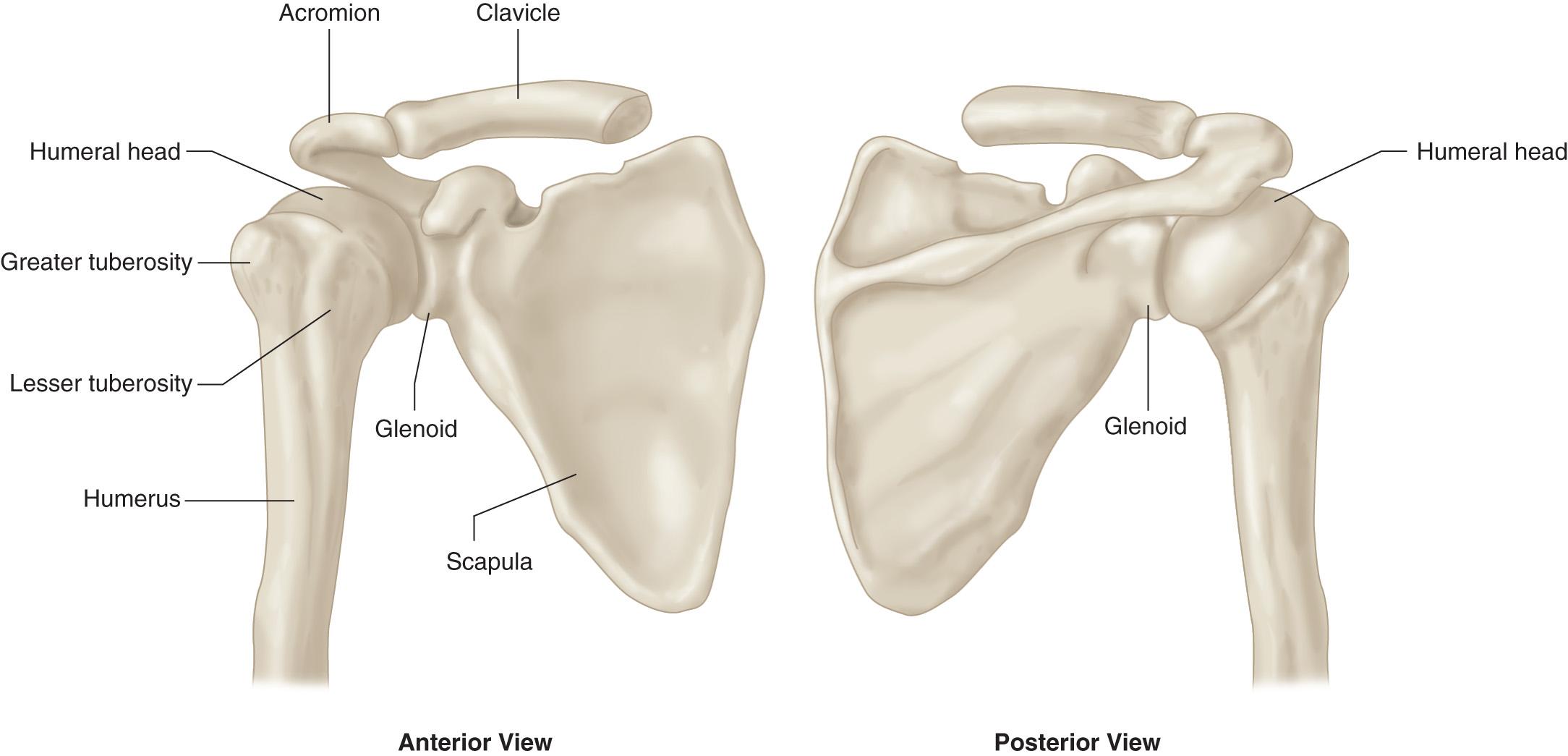
The rotator cuff consists of four muscles: the subscapularis, supraspinatus, infraspinatus, and teres minor muscles ( Fig. 24.2 ). These originate from the scapula and insert on the proximal humerus. Normal rotator cuff tendons are about 4 to 6 mm in thickness, tapering out smoothly from medial to lateral along the insertional footprint at the greater tuberosity. The subscapularis muscle is a multipennate structure that originates from the anterior surface of the scapula, which converges to a flat tendon laterally to insert on the lesser tuberosity. Of note, the inferior one-third of the subscapularis remains muscular to the level of the lesser tuberosity. The supraspinatus muscle originates from and occupies the supraspinatus fossa, with its tendon extending laterally to insert on the greater tuberosity of the humerus at its anterior aspect. The tendon has a more cordlike component anteriorly and is flatter and more quadrilateral in short axis at its mid and posterior fibers. The infraspinatus muscle originates at the infraspinatus fossa and passes laterally to insert on the posterosuperior aspect of the greater tuberosity. The fibers of the supraspinatus and infraspinatus tendons merge at their posterior and anterior borders, respectively, forming a conjoint insertion. The teres minor originates along the lateral border of the scapular body and inserts along the posterior aspect of the greater tuberosity, inferior to the infraspinatus.
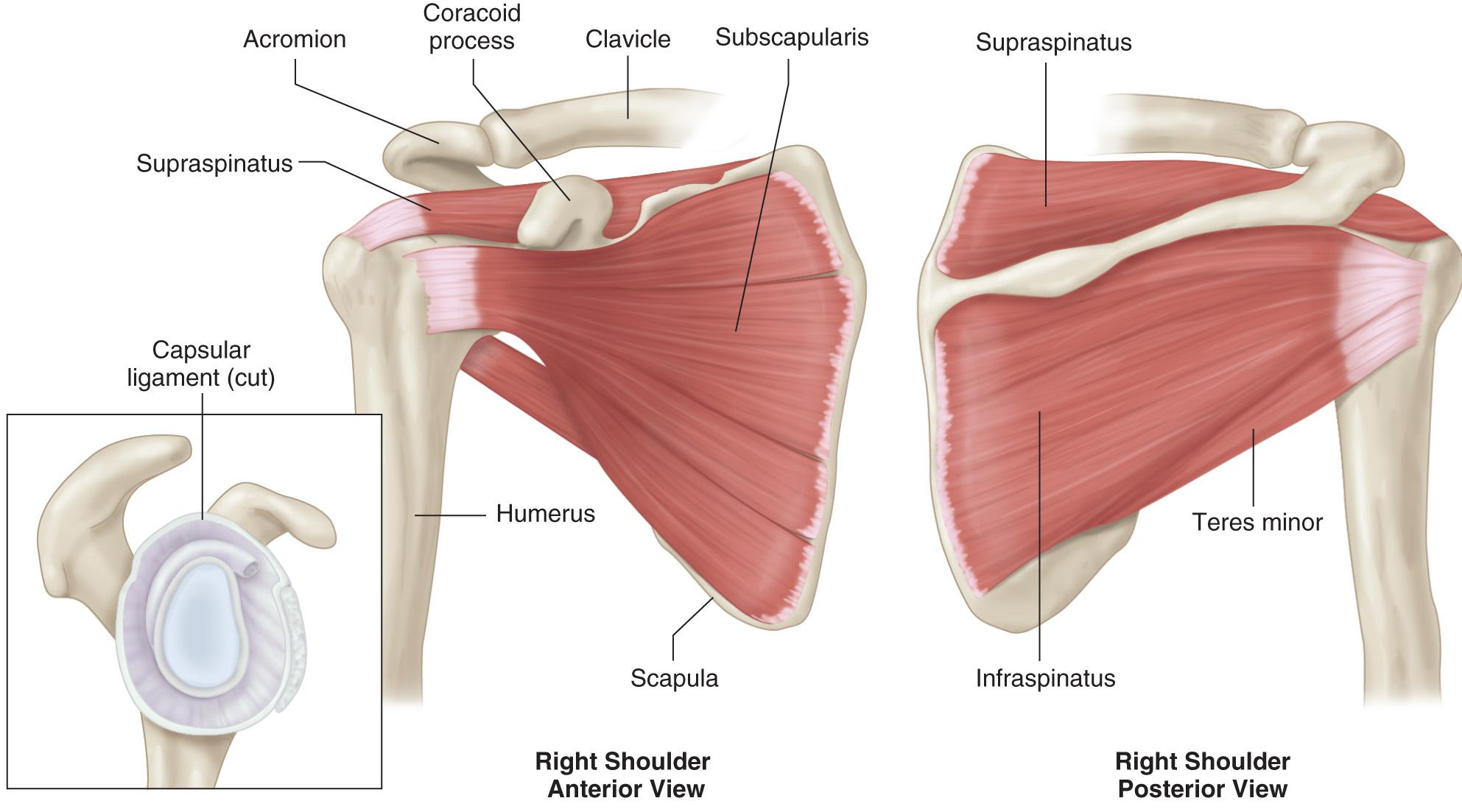
The long head of biceps tendon originates from a bony tubercle at the superior glenoid, the supraglenoid tubercle, and from the superior labrum. It passes inferolaterally between the subscapularis and supraspinatus tendons, which form the inferior and superior borders of the rotator interval ( Fig. 24.3 ). Within the rotator interval, the tendon is stabilized by a ligamentous sling formed by the coracohumeral and superior glenohumeral ligaments. Passing inferolaterally out of the rotator interval, the long head of biceps tendon becomes extraarticular and extends inferiorly in the bicipital or intertubercular groove, which lies between the greater and lesser tuberosities. The biceps tendon is stabilized in the groove by the transverse ligament, formed by tendinous fibers at the subscapularis insertion.
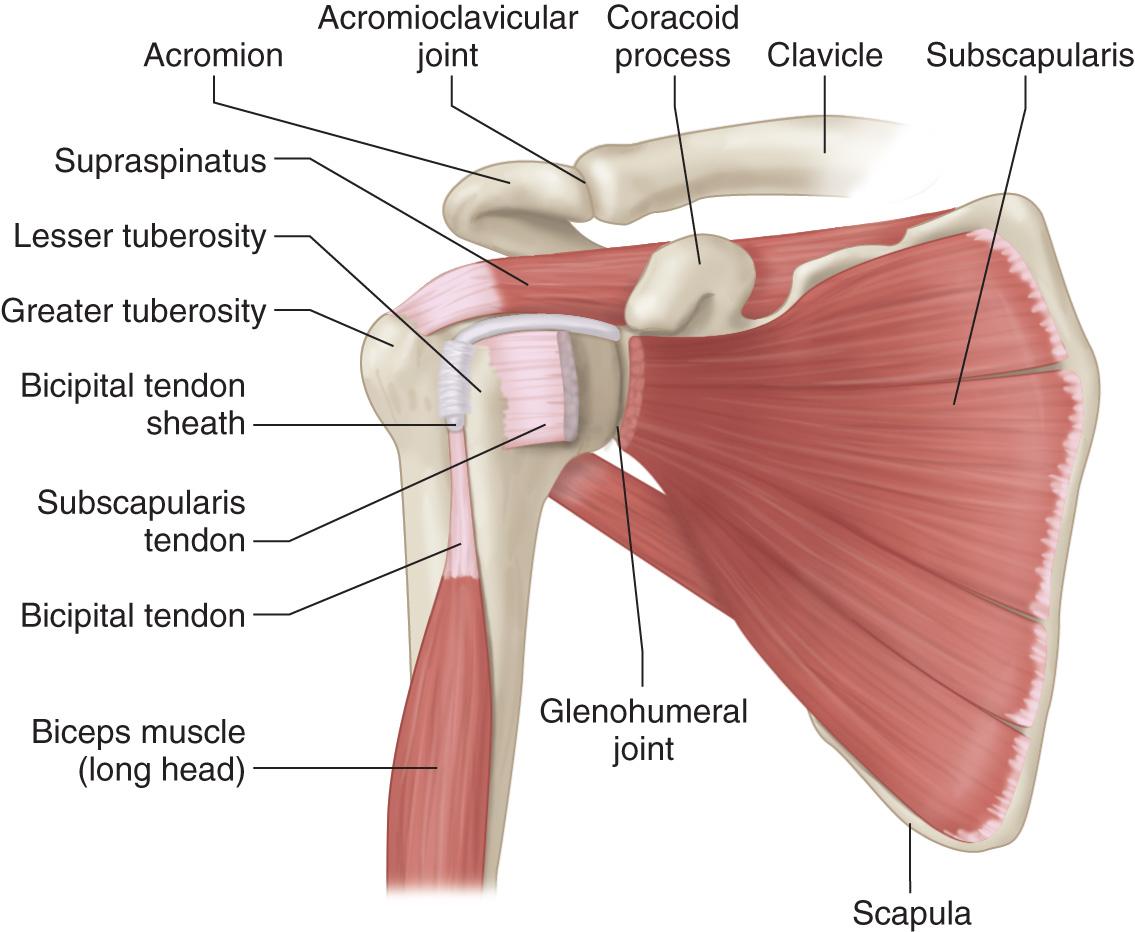
The subacromial-subdeltoid bursa is a synovium-lined flat, thin structure that lies between the rotator cuff tendons and the overlying deltoid muscle and acromion. It serves to reduce friction between the rotator cuff and the overlying structures, permitting smooth movement.
For consistent and accurate shoulder ultrasound performance, a standard protocol is suggested with comprehensive evaluation in every case, rather than targeted scanning ( Table 24.1 ). The patient should be sitting upright if possible, either on a rotating stool or at the edge of a bed. A chair with a backrest should not be used, because this would interfere with patient positioning. Likewise, the sonographer should also sit on a rotating stool, with the seat position somewhat higher than the patient's, so that the sonographer's arm can be held in a natural, ergonomic position. If a patient is wheelchair-bound, it is helpful if possible to temporarily remove the backrest. If the patient cannot sit upright, more limited scanning is possible with the patient lying supine, with the affected shoulder at the edge of the bed. A high-frequency 12- to 15-MHz linear array transducer is used to permit high-resolution scanning. Occasionally, in larger patients, a lower-frequency probe (9 MHz) may be needed to achieve tissue penetration to the required depth, but this incurs a reduction in resolution.
| Long head of biceps tendon | Long and short-axis static images |
| Subscapularis tendon | Long and short-axis static images Dynamic evaluation for subcoracoid impingement |
| Supraspinatus tendon | Long and short-axis static images Dynamic evaluation for subacromial impingement |
| Infraspinatus tendon | Long and short-axis static images |
| Teres minor tendon | Long and short-axis static images |
| Supraspinatus and infraspinatus muscles | Sagittal images—panorama if possible |
| Posterior shoulder | Axial plane image |
| Acromioclavicular joint | Coronal plane image |
When scanning any tendon, care should be taken to maintain an angle of close to 90 degrees between the probe and the tendon of interest to avoid artifactual hypoechogenicity due to anisotropy. This is discussed in more detail later in the chapter.
Biceps tendon evaluation is best performed with the arm in a neutral position, resting the forearm on the patient's ipsilateral thigh, with elbow flexed and the palm up ( Fig. 24.4 ). In this position, the biceps tendon is seen anteriorly. The tendon can be imaged in its short axis within the bicipital groove by holding the probe transversely with respect to the upper arm and following the course of the tendon inferiorly where it passes deep to the pectoralis major tendon insertion on the humerus. In short axis, the tendon appears as a homogeneous, echogenic, round or ovoid structure that may be accompanied by a trace of fluid within its tendon sheath. The normal biceps tendon is 2 to 4 mm thick. The tendon can be followed superiorly and medially into the rotator interval, by angling the probe more obliquely to remain orthogonal to its short axis. Finally, the probe can be rotated 90 degrees to view the tendon in its long axis where it should appear smooth and fibrillar.
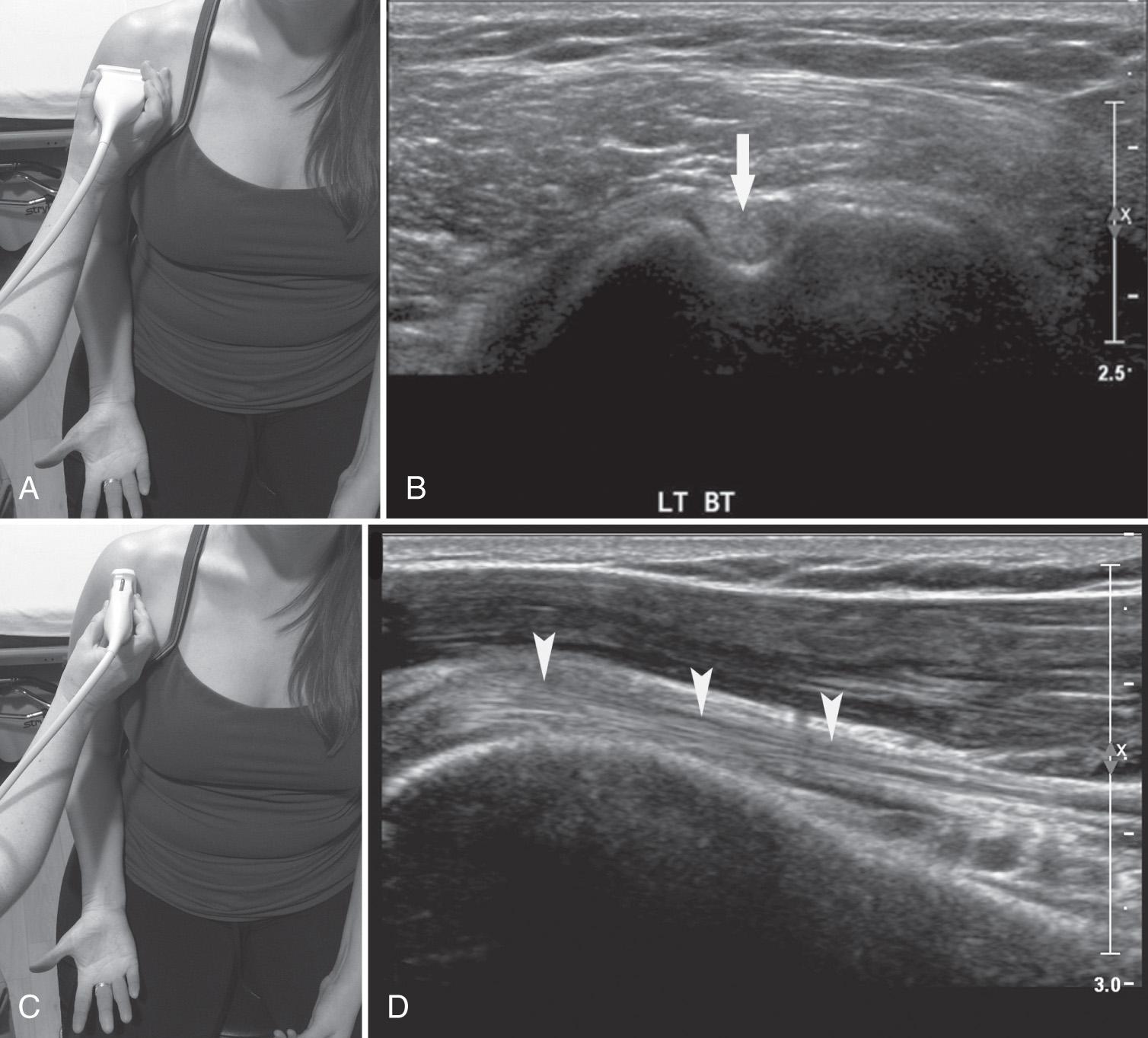
The subscapularis is scanned with the patient's arm at the side, in external rotation with the palm facing up ( Fig. 24.5 ). The tendon should be evaluated in long axis, with the probe aligned with the subscapularis tendon, and in short axis, with the probe held perpendicular to the subscapularis tendon. The coracoid process of the scapula, medial to the subscapularis and palpable in many patients, is a useful anatomic landmark when locating the subscapularis tendon. The tendon fibers can be seen emanating from the broad multipennate muscle belly. The normal hypoechoic muscle should not be mistaken for fluid. In this position the patient's arm can be rotated from external rotation to neutral position, while observing the passage of the tendon fibers deep to the coracoid process to assess for subcoracoid impingement (Video 24.1 ). This dynamic maneuver is also useful to assess for long head biceps tendon subluxation from the bicipital groove.
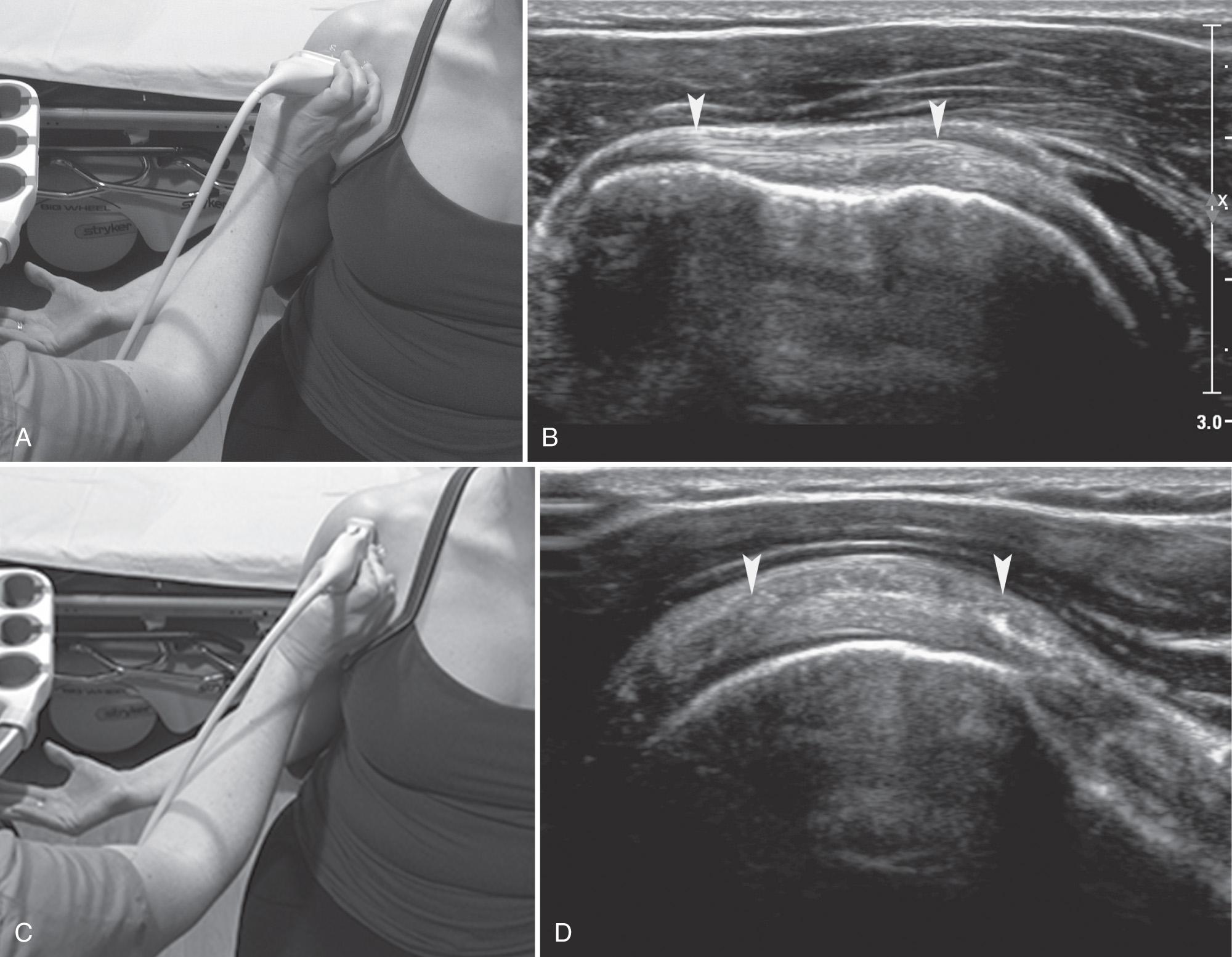
In neutral position the supraspinatus tendon is largely obscured from view by the overlying acromion. To draw the tendon out from under the acromion, specific maneuvers are needed. The position, originally described by Crass ( Fig. 24.6 ), consists of asking the patient to place his or her hand behind the back, reaching toward the opposite back pocket with the back of the hand. This results in flexion, internal rotation, and adduction of the shoulder. In this position, the greater tuberosity is located anteriorly, so the supraspinatus tendon courses anterolaterally to its insertion and is drawn out from under the acromion, allowing visualization. Patients with shoulder pain often find this position difficult to achieve and maintain, so an alternative position is the “modified Crass position” ( Fig. 24.7 ) in which the patient puts the palm of the hand on the ipsilateral hip or buttock, with elbow flexed and directed posteriorly. In this position, the greater tuberosity is similarly positioned as in the original Crass position, but the maneuver is usually well tolerated by patients. The supraspinatus tendon will again course anterolaterally to the greater tuberosity.
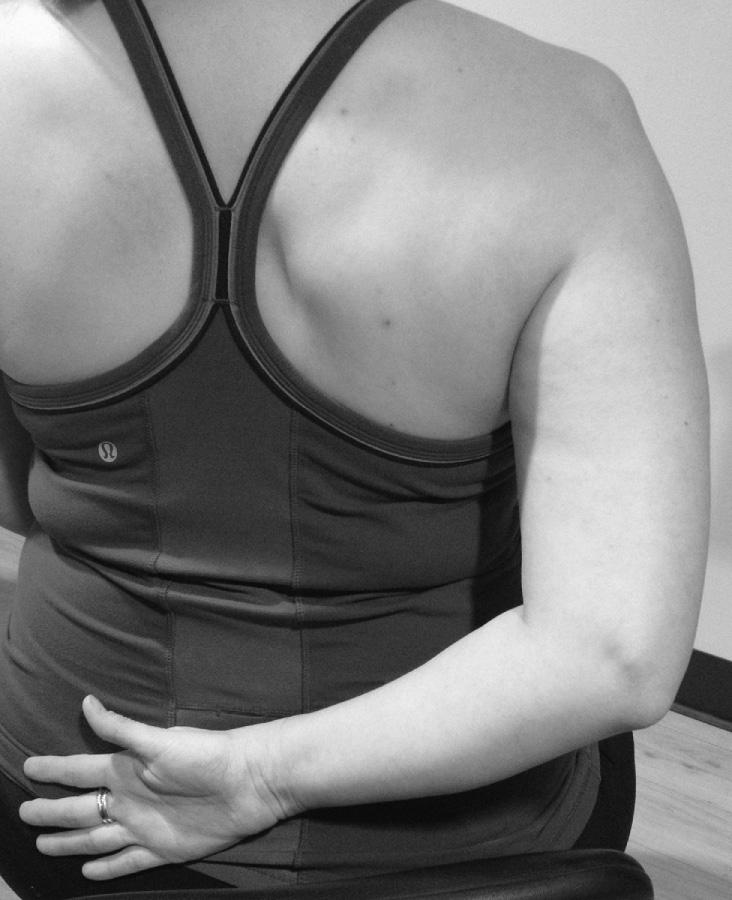
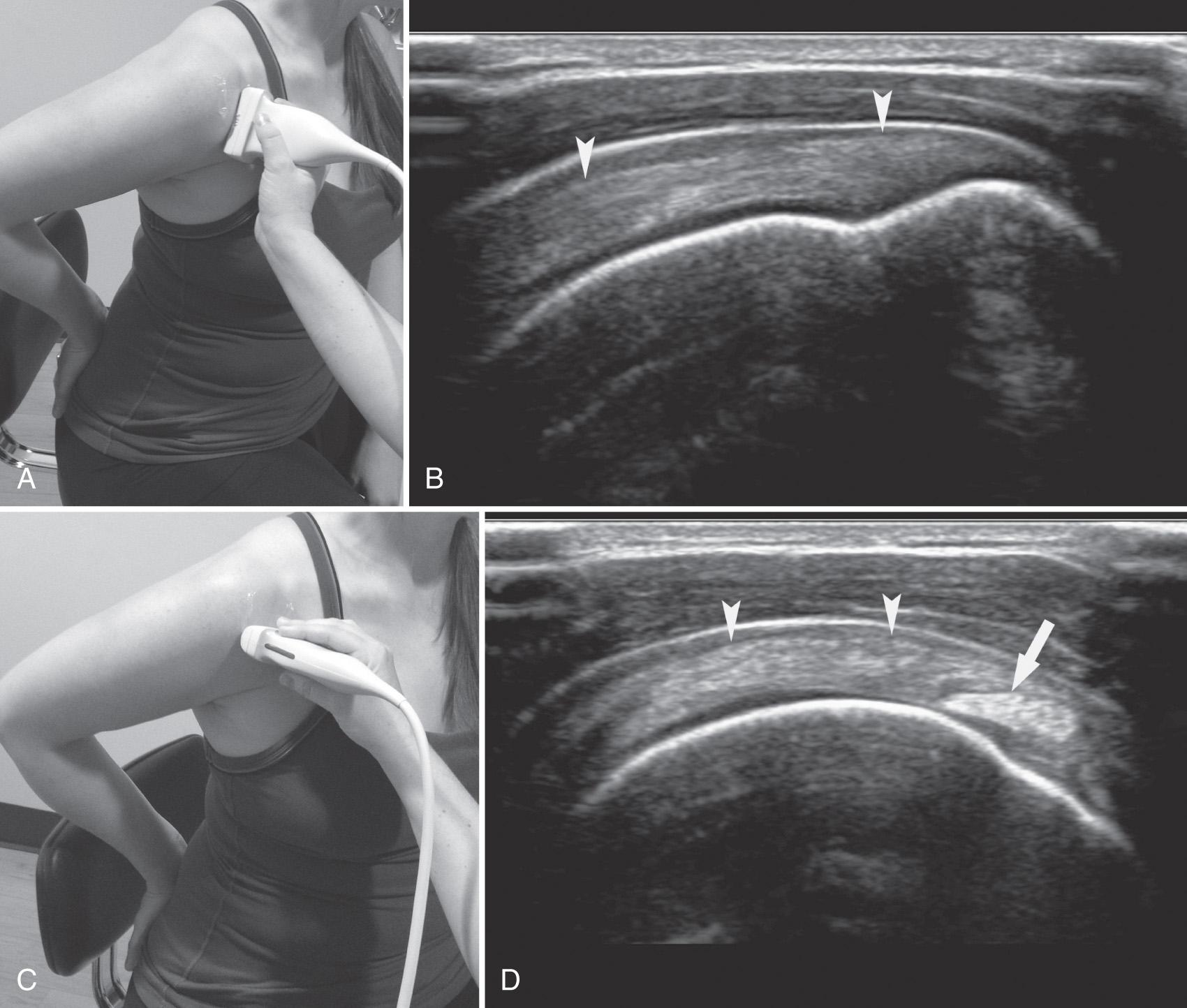
To visualize the supraspinatus in long axis, the probe should parallel the long-axis orientation of the tendon, resulting in an oblique sagittal probe position relative to the patient, with the probe directed toward the patient's ear (see Fig. 24.7A ). The long head biceps tendon in long axis with the patient in the modified Crass position is a useful landmark for locating the most anterior portion of the supraspinatus tendon ( Fig. 24.8 ). If the probe in long axis is then moved posteriorly in the same plane, the entire supraspinatus will be assessed. Correctly imaged, the normal supraspinatus should appear smooth, echogenic, and fibrillar, tapering at its insertion or “footprint” with a so called “bird's beak appearance.” Normal rotator cuff tendons possess a fibrocartilaginous interface at their bony attachment that may manifest as a thin hypoechoic band paralleling the insertional cortex, similar in echogenicity to hyaline cartilage. This should not be mistaken for a tear.
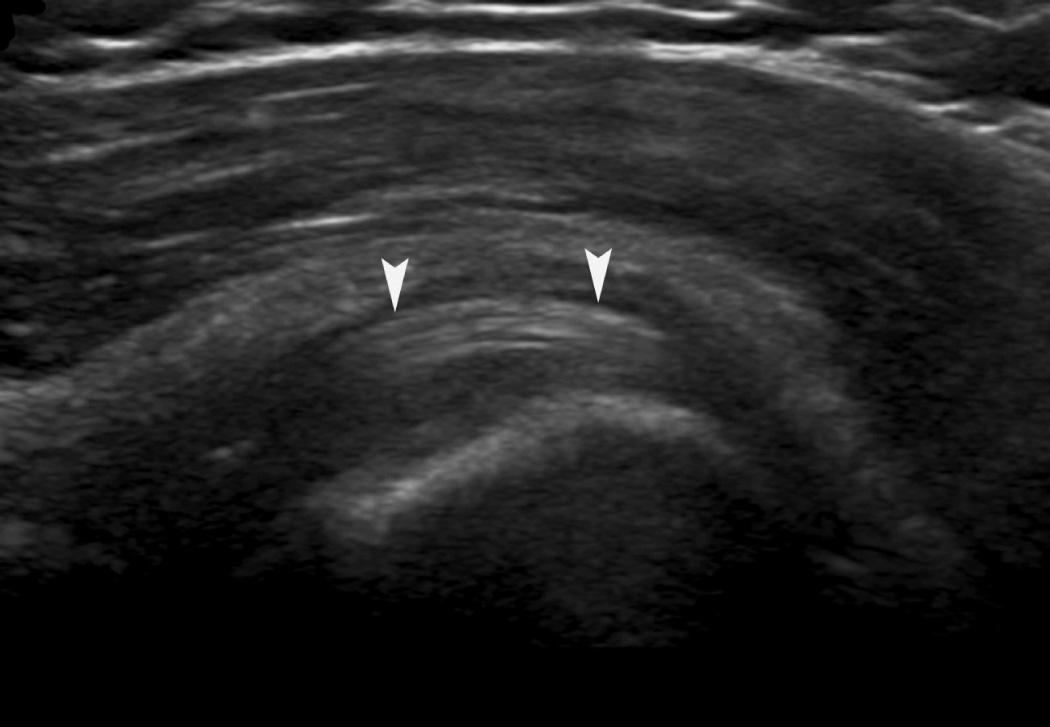
The probe is then rotated 90 degrees to image the tendon in short axis. In this position, the more cordlike anterior fibers of the supraspinatus tendon are seen merging with the flatter quadrilateral mid and posterior fibers. While visualizing the supraspinatus tendon in short axis, it is important to move the probe anteriorly so that the long head biceps tendon is imaged in short axis. This ensures that the entire anterior leading edge of the supraspinatus has been evaluated. In short axis, the rotator interval is well seen anterior to the tendon, with the biceps tendon coursing through the interval, also in short axis, stabilized by the coracohumeral ligament and superior glenohumeral ligament.
As with all tendons, the supraspinatus should be scanned through its entirety from anterior to posterior in long axis and medial to lateral in short axis. When the posterior fibers of the supraspinatus tendon are reached, the more posteriorly oriented fibers of the infraspinatus tendon are routinely encountered; this is a helpful landmark to ensure the entire supraspinatus tendon has been studied. It is important to note that as the transducer is moved posteriorly, the greater tuberosity changes shape, from ledgelike to flat. This area of transition is where the anterior infraspinatus fibers overlap the posterior supraspinatus fibers. A discrete overlap of fibers can be visualized at this juncture ( Fig. 24.9 , Video 24.2 ). Continuing posteriorly from this overlap, the infraspinatus fibers can be evaluated in their entirety, looking for the similar normal fibrillar pattern in the long axis, and the echogenic appearance in the short axis.
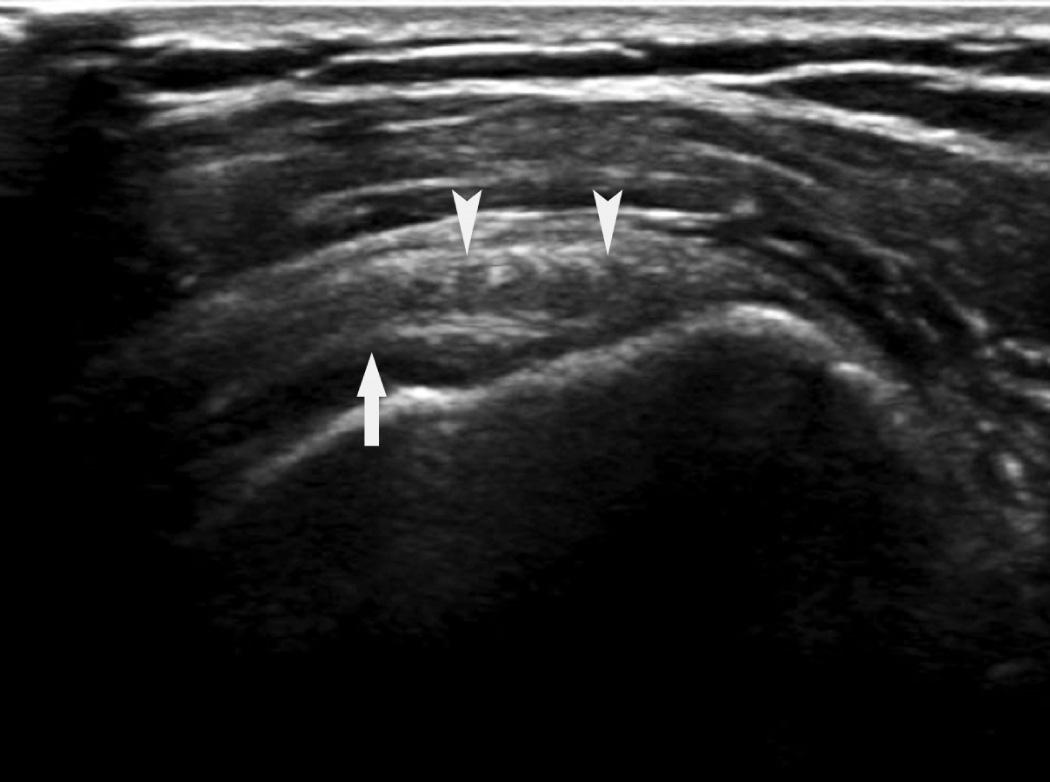
The rotator cable is a thin fibrous band contiguous with the coracohumeral ligament that passes along the deep surface of the supraspinatus and infraspinatus tendons. This bandlike structure is oriented perpendicular to the long axis of the rotator cuff, running in an anterior to posterior direction, and is felt to have a biomechanical role in stress distribution, likened to the cable of a suspension bridge. It can be visualized consistently with ultrasound, seen in its short axis where it appears elliptical, when scanning the long axis of the supraspinatus and infraspinatus ( Fig. 24.10 ). It is located about 1 cm (average 9 mm, range 4-15 mm ) medial to the rotator cuff insertion at the greater tuberosity.
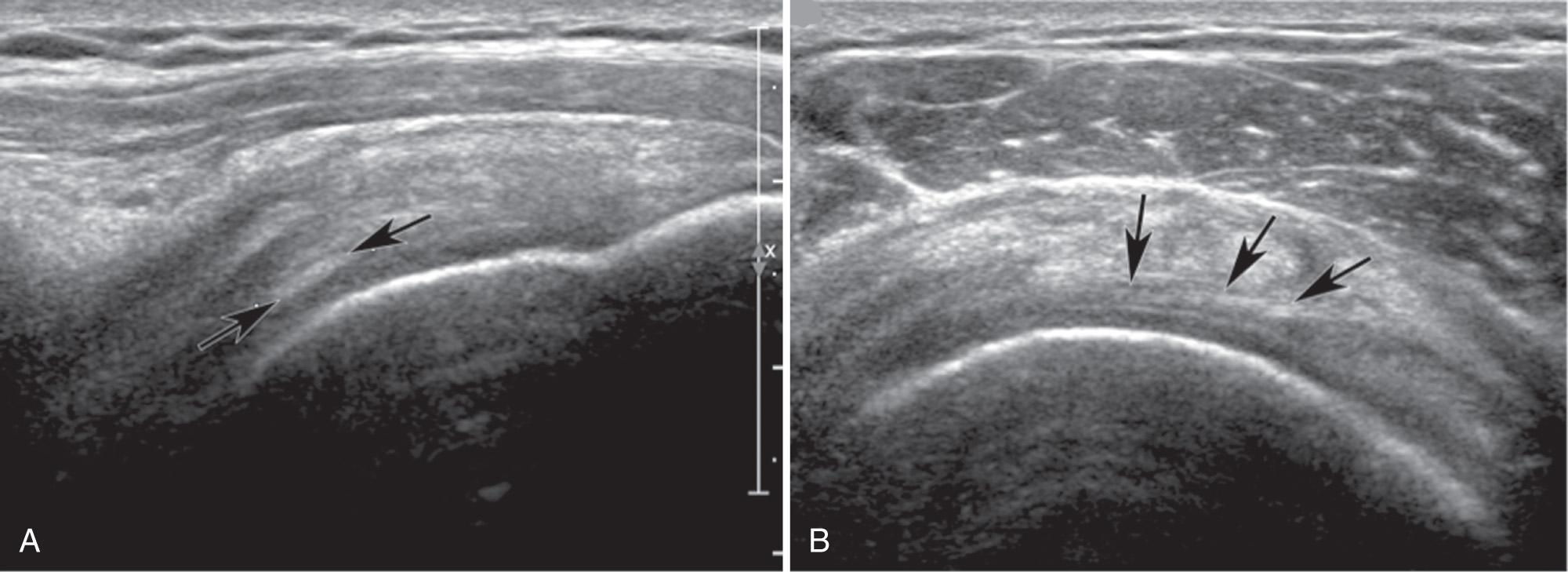
Dynamic assessment for subacromial impingement of the supraspinatus can now be performed. The patient's arm rests in a neutral position at his or her side, and the probe is positioned in a coronal plane, with the acromion at the medial aspect of the field of view, and the greater tuberosity laterally. The patient then abducts the arm slowly, and the motion of the supraspinatus tendon under the acromion is observed. The motion should be smooth and uninterrupted, without deformation of the tendon under the acromion, deformation of the bursa, or pooling of bursal fluid (Video 24.3 ).
A useful alternative technique to assess the supraspinatus has been described by Turrin and Cappello. In this technique, the patient lies supine with the affected shoulder at the edge of the bed, but allows the arm to drop over the side of the bed, with the elbow extended and the forearm pronated. This can be particularly helpful in patients who are unable to sit—for example following cerebrovascular accident with hemiplegia, when associated shoulder pain is not uncommon, though of varied etiology (related to subluxation, spasticity, adhesive capsulitis, or rotator cuff tears ), and standard positioning in the seated position may be difficult.
Several methods of evaluation of the infraspinatus have been described. The patient can remain in the modified Crass position, or with the arm hanging at the side, and scanning can simply be continued posteriorly from the supraspinatus both in long and short axis.
An alternate position of scanning the infraspinatus has been described, in which the patient is asked to bring the arm forward across the chest, resting the hand on the contralateral shoulder. These positions allow imaging of the infraspinatus tendon and muscle. The probe is held in an oblique transverse orientation, placed on the posterior shoulder to parallel the long axis of the infraspinatus tendon, using the inferior border of the scapular spine as a visual landmark ( Fig. 24.11 ). In long axis the tendon appears similar to the supraspinatus in morphology, although having a more elongated tapered appearance at its insertion, lacking the bird's beak appearance seen at the supraspinatus footprint. The probe is then rotated 90 degrees, to the short axis of the infraspinatus, and the tendon and muscle are evaluated. The normal muscle is hypoechoic and positioned below the scapular spine in the infraspinatus fossa.
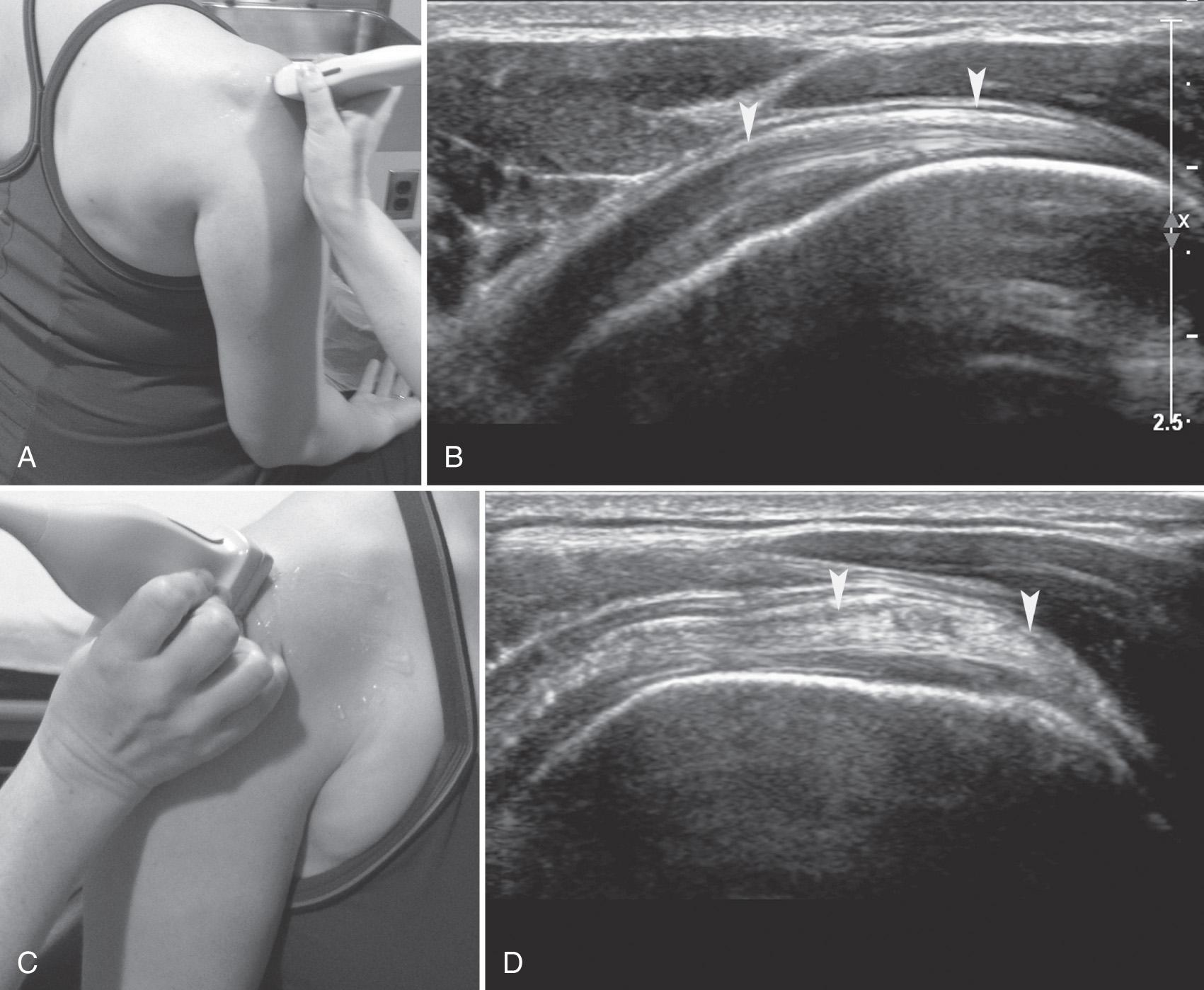
The teres minor tendon is also evaluated in this position and is seen inserting at the posterior aspect of the greater tuberosity, inferior to the infraspinatus insertion. The teres minor muscle can be seen arising from the posterolateral scapula, inferior to the infraspinatus muscle.
Also in this position, the posterior shoulder is seen, with visualization of glenohumeral joint fluid and limited views of the posterior labrum and spinoglenoid notch. Scanning the posterior shoulder with external rotation may aid visualization of a glenohumeral effusion.
Become a Clinical Tree membership for Full access and enjoy Unlimited articles
If you are a member. Log in here